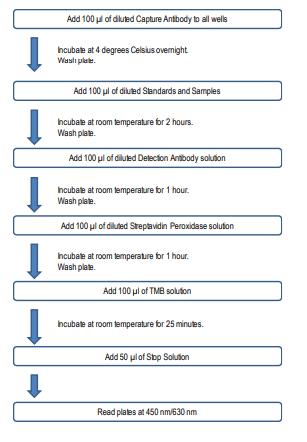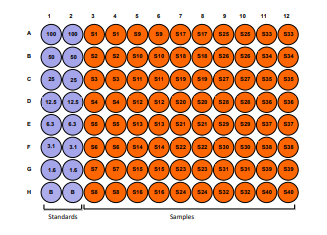Description
Mouse Total IgE (IgEa and IgEb) Detection Kit - Cat Number: 3005 From Chondrex.
Research Field: Immunology
Clonality: N/A
Cross-Reactivity:
Host Origin: N/A
Applications: N/A
Isotype: N/A
Detection Range: 100 ng/ml-1.6 ng/ml
Sample Type: Serum, Plasma
Concentration: N/A
Immunogen:
DESCRIPTION: ELISA kit to quantify total mouse IgE antibodies
FORMAT: 96-well ELISA plate with removeable strips
ASSAY TYPE: Sandwich ELISA
ASSAY TIME: 4.5 hours
STANDARD RANGE: 100 ng/ml to 1.6 ng/ml
NUMBER OF SAMPLES: Up to 40 (duplicate) samples/plate
SAMPLE TYPES: Serum & Plasma
RECOMMENDED SAMPLE DILUTIONS: 1:100 or greater
CHROMOGEN: TMB (read at 450 nm)
STORAGE: -20°C for 12 months
VALIDATION DATA: Intra-Assay (0.3-3%)/Inter-Assay (1.9-3%)/Spiking Test (95-98%)
NOTES:
INTRODUCTION
Type I hypersensitivity, which is characterized by an allergic reaction immediately following contact with innocuous antigens, is a typical clinical feature of allergic diseases, such as asthma, eczema, hay fever, and urticaria. This hypersensitivity is mediated by IgE antibodies, the so-called “atopic reagin” and the clinical features of type I hypersensitivity are described as “atopy”. IgE antibodies bind to high affinity IgE receptors (FcεRI) on mast cells and basophils and drastically up-regulate FcεRI expression through stabilization and accumulation of FcεRI (1), enhancing hypersensitivity responses to allergens.
The specific allergen bound to IgE antibodies on the cell surface cross-links FcεRI (2-3), which leads to the stimulation and degranulation of mast cells. This is associated with the release of a variety of proinflammatory mediators and cytokines such as histamine, proteolytic enzymes, heparin, and chemotactic factors, which cause the symptoms associated with type I hypersensitivity. In order to study the pathogenesis of allergic diseases, mice are the most practical experimental animals, due to the variety of inbred strains and transgenic and gene knockout mice that are available.
Serum IgE antibody levels are often elevated in allergic diseases and parasitic infections, although serum IgE level alone does not reflect the allergic state and the clinical symptoms of the patient. However, it is apparent that an elevated serum IgE level aids in the diagnosis of these diseases in humans. The Mouse Total IgE Detection ELISA Kit (Catalog # 3005) is designed to determine total IgE levels in mouse sera. Both of the capture and detection monoclonal antibodies used in this kit do not cross-react with any other mouse immunoglobulin subclasses and subtypes (IgA, IgM, IgG, IgG1, IgG2a, IgG2b, IgG2c, and IgG3) and both react equally with both IgEa (Balb/c) and IgEb (C57BL/6) allotypes, so it is not necessary to run two separate assays using two independent IgEa and IgEb standards.
KIT COMPONENTS

ASSAY OUTLINE

PLATE MAPPING







